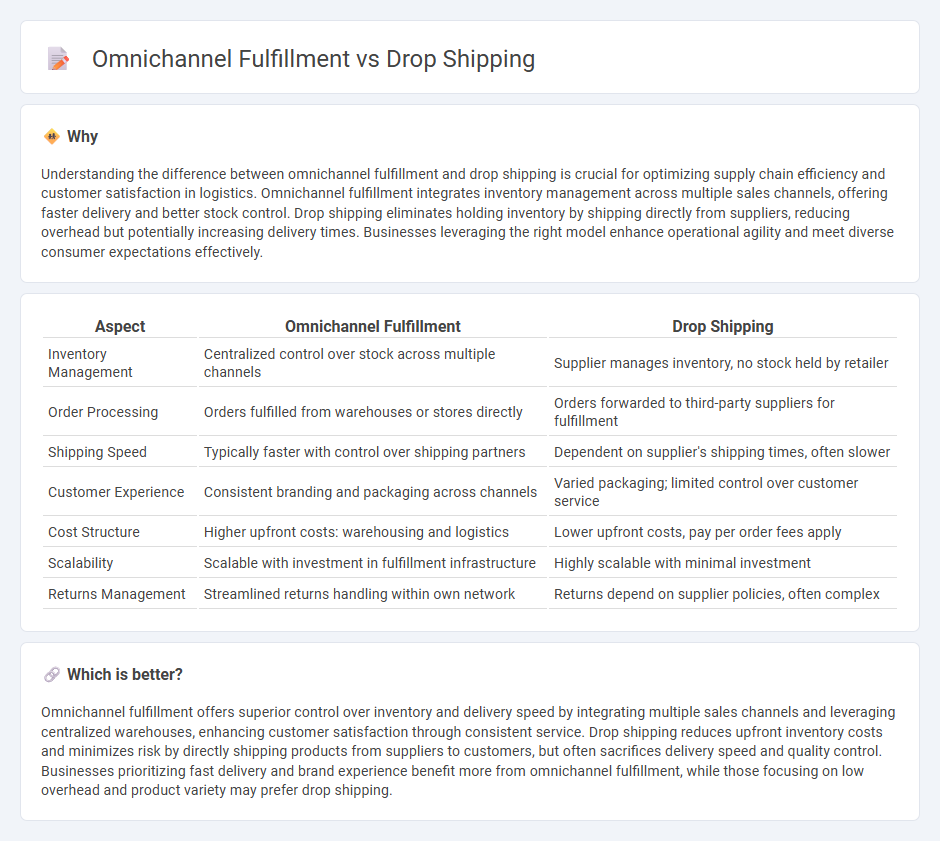
Omnichannel fulfillment integrates multiple sales channels to streamline inventory management, improve customer experience, and ensure faster delivery through centralized warehouses and local stores. Drop shipping eliminates the need for inventory by having suppliers directly ship products to customers, reducing overhead but potentially increasing delivery times. Explore how these fulfillment models impact logistics efficiency and customer satisfaction.
Why it is important
Understanding the difference between omnichannel fulfillment and drop shipping is crucial for optimizing supply chain efficiency and customer satisfaction in logistics. Omnichannel fulfillment integrates inventory management across multiple sales channels, offering faster delivery and better stock control. Drop shipping eliminates holding inventory by shipping directly from suppliers, reducing overhead but potentially increasing delivery times. Businesses leveraging the right model enhance operational agility and meet diverse consumer expectations effectively.
Comparison Table
| Aspect | Omnichannel Fulfillment | Drop Shipping |
|---|---|---|
| Inventory Management | Centralized control over stock across multiple channels | Supplier manages inventory, no stock held by retailer |
| Order Processing | Orders fulfilled from warehouses or stores directly | Orders forwarded to third-party suppliers for fulfillment |
| Shipping Speed | Typically faster with control over shipping partners | Dependent on supplier's shipping times, often slower |
| Customer Experience | Consistent branding and packaging across channels | Varied packaging; limited control over customer service |
| Cost Structure | Higher upfront costs: warehousing and logistics | Lower upfront costs, pay per order fees apply |
| Scalability | Scalable with investment in fulfillment infrastructure | Highly scalable with minimal investment |
| Returns Management | Streamlined returns handling within own network | Returns depend on supplier policies, often complex |
Which is better?
Omnichannel fulfillment offers superior control over inventory and delivery speed by integrating multiple sales channels and leveraging centralized warehouses, enhancing customer satisfaction through consistent service. Drop shipping reduces upfront inventory costs and minimizes risk by directly shipping products from suppliers to customers, but often sacrifices delivery speed and quality control. Businesses prioritizing fast delivery and brand experience benefit more from omnichannel fulfillment, while those focusing on low overhead and product variety may prefer drop shipping.
Connection
Omnichannel fulfillment and drop shipping are interconnected strategies that enhance supply chain efficiency by integrating multiple sales channels with direct product delivery from suppliers. Drop shipping supports omnichannel fulfillment by enabling retailers to offer a broader product range without holding inventory, facilitating faster order processing and shipping. This synergy improves customer experience through seamless order management, reduced logistics costs, and increased delivery speed across various platforms.
Key Terms
Inventory Management
Drop shipping eliminates the need for inventory management by directly shipping products from suppliers to customers, reducing storage costs and risks of overstocking. Omnichannel fulfillment requires synchronized inventory management across multiple sales channels and warehouses to ensure product availability and timely delivery. Explore how each strategy impacts your supply chain efficiency and customer satisfaction.
Order Processing
Dropshipping minimizes inventory handling by directly transferring customer orders to suppliers, streamlining order processing and reducing fulfillment time. Omnichannel fulfillment requires integrated systems to manage orders from multiple sales platforms, ensuring accurate inventory synchronization and unified order tracking. Explore more to understand which method best enhances your order processing efficiency.
Customer Experience
Dropshipping offers direct-to-consumer shipping without inventory holding, enabling faster product variety expansion but often sacrificing control over packaging and delivery times. Omnichannel fulfillment integrates multiple sales channels and inventory management, providing consistent and faster shipping options, enhancing reliability and customer satisfaction. Explore how these models impact your customer experience strategy for optimized service delivery.
Source and External Links
Drop shipping - Wikipedia - Drop shipping is a retail business model where the seller takes customer orders without stocking products, instead forwarding orders to a manufacturer or wholesaler who ships directly to the customer, thus reducing overhead costs but also limiting quality control and profit margins.
What Is Dropshipping and How Does It Work? (2025) - Shopify - Dropshipping involves partnering with suppliers who store and ship products, while the seller markets and sells through an online store, automatically forwarding customer orders to suppliers who ship directly to the customer.
What Is Dropshipping and How Does It Work? - Wix - Dropshipping is a retail fulfillment method where the seller does not hold inventory but instead purchases products from third-party suppliers to fulfill customer orders, focusing primarily on marketing and pricing while letting suppliers handle storage and shipping.
 dowidth.com
dowidth.com